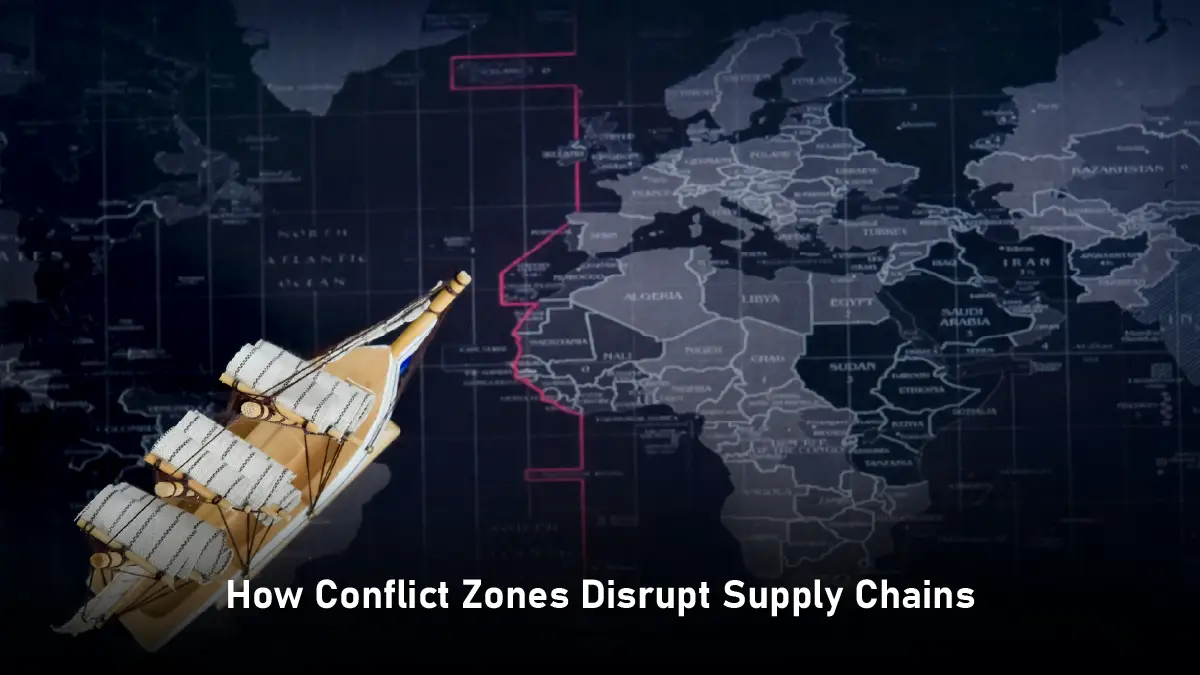Logistics means moving goods from one place to another. The biggest challenges are controlling cost, time, and efficiency. But it becomes much harder when working in areas with conflict or political problems. This challenging environment is known as contested logistics.
Contested logistics refers to supply chains facing deliberate disruptions or attacks by hostile forces. These threats may include blocking ports, attacking ships, or interfering with communication systems to slow or stop the flow of goods. Contested logistics also involves active attempts to disrupt supply chains.
Supply chains link businesses and customers around the world. When key ports and shipping routes become conflict zones, the whole supply chain faces risks and problems. Businesses and governments must carefully plan to keep products moving despite these concerns because many important trade routes pass through unstable areas.
Also Read: The Role of Failure Analysis in Enhancing Product Reliability
This blog will discuss how supply chains are impacted by contested logistics and offer doable tactics to lower risks when ports and shipping lanes turn into conflict areas. We aim to support companies in navigating these risks and ensuring that goods continue to flow even in challenging situations.
How Conflict Zones Disrupt Supply Chains

Several problems arise when shipping routes pass through conflict zones:
- Ships may need to wait for clearance or reroute to avoid danger. This adds days or weeks to delivery times.
- Longer routes increase fuel consumption and insurance premiums. Freight rates often rise sharply in high-risk areas.
- Conflicts can reduce port capacity. This causes congestion and slower unloading of goods.
- Disruptions can lead to shortages of goods and raise costs. In fact, supply chain disruptions cost companies about US$ 184 billion
- Sudden changes in security conditions make planning difficult for logistics managers.
Real-world Examples
Some shipping routes are very important for world trade. The Suez Canal and the Strait of Hormuz are narrow waterways that carry a lot of global trade. The global impact of conflict in these areas is huge. Here are some examples:
The Red Sea Crisis
In recent years, attacks on cargo ships have increased in the Red Sea. Shipping companies have been forced to reroute around Africa. This is mainly due to the Houthi group’s bombing of vessels in Yemen. This increases the cost and duration of each trip by thousands of miles. The number of ships going through the Suez Canal has now decreased by over 50%. Many companies faced higher shipping costs, delays, and closure of factories while they wait for parts.
The Black Sea and Russia-Ukraine Conflict
The conflict between Russia and Ukraine made the Black Sea unsafe for shipping. Ports were closed or operated at reduced capacity. Ships were attacked and had to wait for safe passage. Many companies had to find alternative routes to transport goods. This came at a higher cost and longer transit times.
These examples show that conflicts in important shipping routes can cause delays, raise prices, and make goods harder to get.
Key Strategies for Mitigating Risk

Keeping supply chains running in conflict areas needs careful planning and good risk management. Here are the top strategies:
Diversify Shipping Routes – Using one shipping lane is risky. Companies should explore alternative routes to reduce exposure to high risk areas. For example, when the Red Sea got dangerous, many companies started sending ships around the Cape of Good Hope though it was longer and more expensive. Not always ideal but having a backup route keeps goods moving when the primary lane is blocked.
Conduct Real-time Monitoring – Companies can use real-time tracking to watch their shipments and react to new problems. Advanced tools can help find risks early and decide if shipments need to be rerouted or delayed.
Work with Partners – Working with shipping companies, insurers, and international groups helps get important information and support. For example, naval escorts can protect ships traveling through risky waters.
Make Backup Plans – Companies should prepare for small delays and big problems. Plans should have backup suppliers, emergency shipping routes, and clear ways to communicate. These plans should be checked often to make sure they work.
Diversify Suppliers and Manufacturing Locations – Depending on one supplier or country for components is risky. Companies need to begin sourcing from multiple suppliers in different regions. This reduces their exposure to disruptions in any one area.
Invest in Flexible Logistics Solutions – Multi modal transportation options that use a mix of sea, air, rail and road allows companies to switch modes if one becomes unavailable. This flexibility keeps goods moving even when traditional routes are blocked.
Use Technology for Risk Assessment – AI and blockchain can help companies track goods and assess risks across complex supply chains. These tools provide secure records and help identify weak points.
Case Study: Lessons from Recent Supply Chain Disruptions
The Automotive Industry and the Ukraine Conflict
The Russia-Ukraine conflict hurt global supply chains, especially in the car industry. Many companies relied on parts and materials like palladium and steel from Russia and Ukraine. Delivery times increased, prices increased, and supply of these essential items dried up as the conflict progresses. The use of palladium in catalytic converters went up by over 30%. European car makers faced delays because Ukrainian factories that made car wiring closed. This made businesses change their plans and find better ways to strengthen their supply chains.
The conflict showed us why it’s important to map and see the whole supply chain clearly. Businesses who were aware of their supply chains were able to spot pressure points and take appropriate action. This included creating buffer stockpiles and dual sourcing. The importance of localizing supply chains is another lesson. By moving their sourcing closer to home, businesses reduced their susceptibility to global shocks.
6 Steps to Future-proof Your Supply Chain
1. Establish Robust Supplier Connections
A robust supply chain depends on having trustworthy relationships with its suppliers. Locate vendors who provide premium components on schedule and under budget by using data analysis. You can plan for unforeseen disruptions and track supplier performance with integrated systems. Transparency and problem-solving are also promoted by regular interaction and cooperation with suppliers.
2. Invest in Automation
Automation helps with ordering, packing, and managing stock, making supply chains work better. Modern systems use data to make smart choices, cut costs, and lower risks. Improved supply chains can quickly adjust to changes.
3. Use Different Ways to Move Goods
Using ships, planes, trains, and trucks gives you more choices. Real-time info on cost and time helps pick the best way to move goods. This approach keeps shipments moving even if usual routes are blocked by conflict or disasters.
4. Improve Infrastructure and Technology
Put money into warehouses, transport, and computer systems. Tools like IoT, blockchain, and AI provide real-time updates and clear info. They help track shipments, check inventory, and find problems early before they get worse.
5. Create Backup Plans
A strong supply chain needs backup plans. Companies need to prepare for disruptions and have some plans in place. This means having backup suppliers, emergency shipping routes, and clear ways to communicate. These plans should be checked and practiced often.
6. Communicate and Work Together
Good relationships with suppliers, customers, and the government are very important during conflicts. Everyone may coordinate their response and stay informed when there is communication. Exchange best practices and intelligence to assist businesses lessen the effects of interruptions and quickly adjust to changing circumstances.
Conclusion
Contested logistics can hamper global supply chains. This happens when important shipping routes and ports are in conflict areas. It can cause delays, higher costs, and shortages of important goods. Businesses should use different shipping routes, keep extra stock, and have backup plans. By preparing and adapting, they can keep goods moving even during political problems. In today’s complex world, understanding contested logistics is essential for global trade and economic stability.




